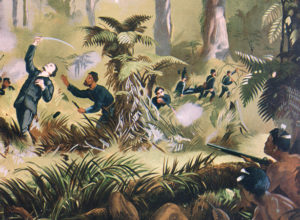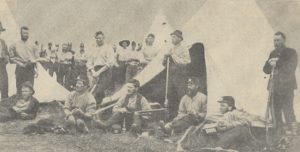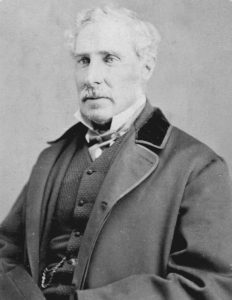2020: Historical Report on Hamilton Street and City Names
June 28, 2020
By AHNZ
 This month, June 2020, Hamilton City Council famously tore out the statue of the man their city was named after, Captain John Hamilton. They did this because they understood that the temporary flare up of Black Lives Matter protestors had the agenda of vandalising the statue themselves. The city wanted to get in first.
This month, June 2020, Hamilton City Council famously tore out the statue of the man their city was named after, Captain John Hamilton. They did this because they understood that the temporary flare up of Black Lives Matter protestors had the agenda of vandalising the statue themselves. The city wanted to get in first.
Hamilton’s politicians quickly followed this act up by paying mainstream historian Vincent O’Malley (left) $10,000 to character assassinate independently report on 4 targeted figures in New Zealand history. Waikato-Tainui Maori also chipped in for this report. The politicians have the view of stripping these figures from Hamilton’s cultural fossil layer. The targeted figures are: John Hamilton, George Grey, Gustavus von Tempsky, John Bryce.
Not for $10,000 but for free, here’s a review of O’Malley’s findings.
John Fane Charles Hamilton (1820-1864)
O’Malley starts his report by saying that Captain John Fane Charles Hamilton was “recently killed during the battle of Pukehinahina (Gate Pā)..” Of course that’s just bad proof reading by whoever checked O’Malley’s final draft and by whoever it was at the City Council and also at Waikato-Tainui who checked the work first before publishing it. Literacy standards have dropped these days with our politicians, tribal leaders, historians, everybody. I wont assume this mistake slipped through due to apathy or disinterest but just because English is hard. Of course, Hamilton died over 150 years ago, not “recently.”
O’Malley also notes that “Captain Hamilton famously never visited the settlement that would come to be named after him.” Of course, this is quite the norm. Did Lord Auckland ever visit Auckland, the Duke of Wellington visit New Zealand? Did Admiral Nelson ever visit Nelson? No, never, of course not.
Sir George Grey (1812-1898)
O’Malley’s report is very matter-of-fact but I suspect he’s providing ammunition for others to look down by presenting the following…
“Grey was speared by an Indigenous Australian, who he shot and killed…He married Eliza Lucy Spencer…She was 16 years old and more than 10 years younger than George..”
In current year, it seems like he’s an unjustified killer of black men and abductor of young girls.
“…at Wairau in June 1843, Ngāti Toa rangatira Te Rauparaha and Te Rangihaeata had sought to resist the illegal survey and occupation by the New Zealand Company..”
O’Malley is here inserting into his “independent report” his own legal opinion as if Wairau were a settled matter. Actually, the NZC had significant legal rights to those plains that revisionist historians gloss over un-remarked.
“In June 1846 Grey captured and kidnapped the elderly Ngāti Toa rangatira, taking him to Auckland and holding him without trial until Te Rauparaha was eventually permitted to return home in 1848.”
O’Malley minimises the savage War Lord Te Rauparaha as if he were Uncle Fluffy the kindly old grandpa. In reality he was a genius general and a blood-thirsty and genocidal war leader during war time.
“Grey revealed a ruthless streak in other ways…Māori captured at Pāuatahanui…one of their number, Hohepa Te Umuroa, contracted tuberculosis and died in captivity..”
People died of TB and/or in C19th prisons all the time, Maoris included. Putting a mark against the Head of State of a nation, Grey, because a prisoner died in an Australian prison is ridiculous and not evidence of a “ruthless streak.” O’Malley also says the Grey had another Maori lynched in jail to enhance his own authority; Hell of a claim to throw around!
“Grey was threatening and aggressive, telling Waikato Māori in a December 1861 meeting that the Kīngitanga should be stopped and would be as a result of his planned scheme of ‘New Institutions’. The governor’s planned rūnanga system was in this way immediately framed as something that had been devised with a view to undermining the Kīngitanga..”
That’s a historian’s spin. Grey’s Runanga System was designed to facilitate Maori self-government at a village council level. Each District Runanga would get to make its own legal by-laws which Grey’s Government would then obediently enforce. The Runanga System/New Institutions was a very progressive and generous way to empower Maoris in the modern world. O’Malley isn’t telling you that, he’s casting it off as “threatening and aggressive” that is “schemed” and “devised” to “undermine.”
“Grey claimed he had been left with no choice but to launch such an invasion, pointing to supposed evidence of an imminent Kīngitanga attack on Auckland. Historians have been highly dismissive of these claims”
Statist historians are dismissive but there is plenty of reason and evidence to support the invasion that Aucklanders feared and that Grey was warned about by the Maori King’s Prime Minister.
O’Malley keeps insisting that Grey was “obsessed” with undermining the Maori King but remember who we’re talking about here: Ptatau Te Wherowhero, the genocidal butcher of the Taranaki. O’Malley is giving that old cannibal the same Uncle Fluffy finessing as he did with Te Rauparaha above.
“What followed at Rangiaowhia in the early hours of Sunday 21 February 1864 – including the deliberate torching of a whare whose inhabitants were killed in the blaze – proved a source of great and enduring pain and bitterness for many Māori.”
O’Malley likes telling this fairytale about Rangiaohia from his own books, a made-up story by one man trying defend himself at the Maori Wars Nuremberg Trials (Ref. 1864: Rangiaohia.) He’s trying to leverage some of that story into his treatise on Grey, to pin it on him.
Gustavus Ferdinand von Tempsky (1828-1868)
 Sure enough, O’Malley takes us back to Rangiaohia again to hang a bit of that on Gustav von Tempsky too…
Sure enough, O’Malley takes us back to Rangiaohia again to hang a bit of that on Gustav von Tempsky too…
“Von Tempsky then described an ‘old looking man’ coming out of the now burning whare with his hands in the air in a gesture of surrender and cries of ‘Spare him!’ ringing around. He noted that some of the men, ‘blinded by rage, at the loss of comrades perhaps’, ignored these pleas, firing at and killing the man”
O’Malley, again at pains to minimise killer Maori men as Uncle Fluffy, leaves out that this ‘old man’ had been offered a way out several times before this final attempt to surrender. A Cavalryman, a soldier, a Colonel, a Corporal, and a Ranger were all gunned down while trying to offer an Olive Branch. (Ref. 1864: Rangiaohia.)
“Although he remains a romantic figure for some, in recent times his reputation has undergone closer examination and critique.”
O’Malley has nothing really bad to say about von Tempsky except to throw this shade: ‘closer examination and critique.’ When you’re being paid $5,000 per person to produce a biography you’re not supposed to allude you’re supposed to supply the goods!
All O’Malley could do was re-tread his Rangiaohia story. Yet who needs Reals when there are Feels? Off the back of this passage, somehow, the newspapers have an article making out von Tempsky as “a pretty mean guy” and “pretty nasty.” Not even the Mayor can articulate what the warrior did that was wrong or why being mean and nasty might not be virtues for an 1860s mercenary (Ref. Life in von Tempsky’s shadow, 27 June, 2020; Stuff)
John Bryce (1833-1913)
“When Bryce came to office, the prophets Te Whiti-o-Rongomai and Tohu Kakaki were leading a campaign of non-violent resistance to the survey of confiscated lands in southern Taranaki from their base at Parihaka..”
 The Parihaka cult leaders above described as “prophets” were actually violent and very disruptive. The Government kept allowing them to squat one someone else’s land and giving them breaks rather than bring them to justice. It was a humanitarian disaster as culture-shocked Maoris struggled to figure out who they were or who to follow in this post-Colonial world. Maoris from different tribes flocked to the cult which took advantage of their superstitions and vulnerability to build a political platform. Bryce wanted to cut through the crap and end a stagnant situation that had dragged on for some 14 years.
The Parihaka cult leaders above described as “prophets” were actually violent and very disruptive. The Government kept allowing them to squat one someone else’s land and giving them breaks rather than bring them to justice. It was a humanitarian disaster as culture-shocked Maoris struggled to figure out who they were or who to follow in this post-Colonial world. Maoris from different tribes flocked to the cult which took advantage of their superstitions and vulnerability to build a political platform. Bryce wanted to cut through the crap and end a stagnant situation that had dragged on for some 14 years.
“His prominent role in the invasion of Parihaka is more clear-cut. It is an incident today widely remembered as deeply shameful.”
It’s true that revisionist historians mutter that the Parihaka take-down was “remembered as deeply shameful” but these are Politically Correct Feels words the same as the ones applied above to von Tempsky (“undergone closer examination and critique.”) The job of the historian should not be to substitute his conclusions for rumours.
O’Malley should investigate the hearsay for validity and if he can’t find any don’t even mention it. What are they paying you for? The girl who lives down von Tempsky Street in Hamilton and the mayor of that city rely on the big gun back-up of O’Malley’s $10,000 judgement. What is backing these decisions to rip out statues or to publish historic figures as “mean and nasty?” “We have to acknowledge that bad things happened,” Hamilton’s mayor says after reading O’Malley’s homework. OK. What things?
O’Malley’s brief is supposed to provide the research framework for Social Justice Warriors to disrespect our ancestors with impunity. They don’t have to take responsibility for what they say, just refer anyone who doesn’t care about their feelings to the $10K report. Yet, upon examination, there’s nothing much in it. O’Malley happily regurgitates his old familiar materials and other well-trodden scripts. Instead of being the back-up for irresponsible mantras he makes them circular by repeating them.
—
Ref. Historical Report on Hamilton Street and City Names FINAL.pdf, 26/6/2020 at 9:17am; Copy of the O’Malley report
6 thoughts on "2020: Historical Report on Hamilton Street and City Names"
Leave a Reply
 Like Comment Share
Like Comment Share







wow! very well contested report! needs to get out there with the haters of colonialism. Misinformation once favourably received is hard to counter.
Very thankful for your appreciation
“O’Malley starts his report by saying that Captain John Fane Charles Hamilton was “recently killed during the battle of Pukehinahina (Gate Pā)..” Of course that’s just bad proof reading by whoever checked O’Malley’s final draft and by whoever it was at the City Council and also at Waikato-Tainui who checked the work first before publishing it. Literacy standards have dropped these days with our politicians, tribal leaders, historians, everybody. I wont assume this mistake slipped through due to apathy or disinterest but just because English is hard. Of course, Hamilton died over 150 years ago, not “recently.””
Your critique of literacy standards, the report’s editor(s) and O’Malley’s general historical practice lends itself to a pretty embarrassing lack of reading comprehension on your part. Stop pretending to be a historian and authority of the English lanuage.
The actual quote from O’Malley’s repot: “The military settlement of Hamilton, established in August 1864 on the site of a Māori kainga known as Kirikiriroa, was named in honour of Captain John Fane Charles Hamilton, recently killed during the battle of Pukehinahina (Gate Pā) on 29 April of that year.”
I’m sorry but your insults don’t make Hamilton’s death, nor the year 1864, “recent.” The word adds only muddle to a sentence that could get on fine without it.
It’s true that this was J.F.C Hamilton’s most recent death…but unless he’s a very old friend of Connor MacLeod of the Clan MacLeod that fact doesn’t save O”Malley or his collaborators.
Very willing to let this technicality go though if that’s the only thing you have to say about revealing this ‘historical report’ as a stitch-up?
See, once again you fail to actually analyze the text of the report. He is not referring to 1864 as a recent event – I think that is quite clear. He is referring to Hamilton’s death as recent to the establishment of the Hamilton settlement.
My insults do point out that you, who wishes to critique and insult O’Malley, are flawed in approach, and have deliberately misused sources to make some weak, watered-down point.
If you can’t get the easy stuff right in your narrative – representing material honestly – then what does it say about your analysis in general? I think you may need to do some historical soul searching and think about whether or not you are just a cheap hack or not.
I know what he wanted to say but I’m responding to what he did say which I think is quite clear too. But this is a quibble. And you’re quibbling about my quibble which is an entire valance ring more quibbilous. You ought to find something substantial to dispute rather than tell yourself that quibbles are a proxy for doing that.
If you must be abusive do it honestly. The name-calling is now being disguised as a desire to “point things out” and an invitation to do some “soul searching.” That’s just sadistic, although you’re probably just repeating bullying done to you in the past that you still don’t know how to stand up to. You’re trying to get me to self-attack and accept abuse on the basis that it’s good for me and will improve me at a soul-level. Did your parents tell you they were hitting you “for your own good” too? You can do better.